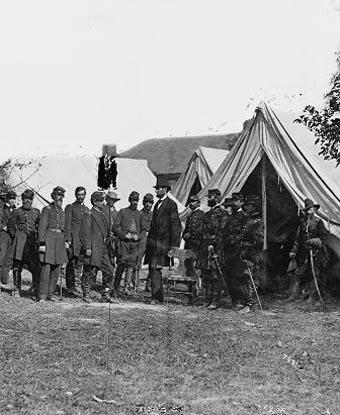Last updated: March 29, 2024
Person
Abraham Lincoln

Library of Congress
Abraham Lincoln was born in 1809 on a small farm near Hodgenville, Kentucky. Due to the remoteness of his upbringing and lack of available public education, Lincoln was mostly self-educated. In 1836, after years of study, he qualified as a lawyer and went to work in a law practice in Springfield, Illinois. He sat in the Illinois state legislature from 1834 to 1842, and in 1846 was elected to Congress, representing the Whig Party for a two-year term. In 1856, he joined the new Republican Party, and in 1858 he ran as their candidate for the US Senate. Though he lost the election, his series of debates with Stephen A. Douglas thrust him into the national spotlight, and in 1860 he was nominated as the Republican candidate for president.
In the presidential campaign, Lincoln made his opposition to the expansion of slavery very clear. His victory provoked a crisis for the southern states, with many fearing that he would attempt to abolish slavery. Seven southern states left the Union to form the Confederate States of America before Lincoln's inauguration. After the bombardment and surrender of Fort Sumter in April 1861, Lincoln called for 75,000 volunteer to put down the rebellion and four more states joined the Confederacy. Lincoln vowed to preserve the Union even if it meant war.
The first year of war was not promising for the Union, and with their defeat in 1862 at the Second Battle of Manassas (Bull Run) it seemed like the second year of war would not be much better. Riding momentum from this victory, Lee and the Confederates staged an offensive with the Maryland Campaign. However the Union victory at the bloody Battle of Antietam pushed the Confederates back across the Potomac and provided Lincoln with an opportunity he had been waiting for to announce his plans regarding slavery.
In the early months of the war, Lincoln maintained that the war was a struggle only to save the Union. After the Battle of Antietam, Lincoln announced the preliminary Emancipation Proclamation. Officially on January 1, 1863 all enslaved people in the Confederate States of America were freed, signifying the Union's war aims had changed to include the abolition of slavery.
In the effort to win the war, Lincoln assumed more power than any president before him, declaring martial law and suspending legal rights. He had difficulty finding effective generals to lead the Union armies until the appointment of Ulysses S. Grant as overall commander in 1864.
By the beginning of his second term in March 1865, the war was clearly in its final days, and in his inaugural address Lincoln summed up the policy he would follow in rebuilding the Union: "With malice towards none, with charity for all." Soon thereafter, on April 9, Confederate General Robert E. Lee surrendered the Confederate armies in Virginia, effectively ending the Civil War. Less than a week later, Abraham Lincoln was assassinated by John Wilkes Booth, a pro-Confederate sympathizer, while attending a performance at Ford's Theatre in Washington, D.C., and died the next morning, April 15, 1865.
